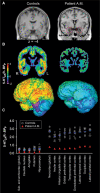Reduced 5-HT(2A) receptor signaling following selective bilateral amygdala damage
- PMID: 19015089
- PMCID: PMC2656878
- DOI: 10.1093/scan/nsn039
Reduced 5-HT(2A) receptor signaling following selective bilateral amygdala damage
Abstract
Neurobiological evidence implicates the amygdala as well as serotonergic (serotonin, 5-HT) signaling via postsynaptic 5-HT(2A) receptors as essential substrates of anxiety behaviors. Assuming a functional interdependence of these substrates, we hypothesized that a low-fear behavioral phenotype due to bilateral lesion of the amygdala would be associated with significant 5-HT(2A) receptor changes. Thus, we used [(18)F]altanserin positron emission tomography (PET) referenced to radioligand plasma levels and corrected for partial volume effects to quantify the spatial distribution of 5-HT(2A) receptor binding potential (BP(P)) in a rare patient with Urbach-Wiethe disease and selective bilateral amygdala calcification damage relative to 10 healthy control subjects. Consistent with our a priori hypothesis, we observed a 70% global decrease in 5-HT(2A) receptor BP(P) in the Urbach-Wiethe patient relative to controls. Thus, brain abnormalities in this patient are not restricted to the amygdala, but extend to overall 5-HT neurotransmission via 5-HT(2A) receptors. Our findings provide important insights into the molecular architecture of human anxiety behaviors and suggest the 5-HT(2A) receptor as a promising pharmacological target to control pathological anxiety.
Figures


Similar articles
-
A nonlinear relationship between cerebral serotonin transporter and 5-HT(2A) receptor binding: an in vivo molecular imaging study in humans.J Neurosci. 2010 Mar 3;30(9):3391-7. doi: 10.1523/JNEUROSCI.2852-09.2010. J Neurosci. 2010. PMID: 20203198 Free PMC article.
-
Frontolimbic serotonin 2A receptor binding in healthy subjects is associated with personality risk factors for affective disorder.Biol Psychiatry. 2008 Mar 15;63(6):569-76. doi: 10.1016/j.biopsych.2007.07.009. Epub 2007 Sep 19. Biol Psychiatry. 2008. PMID: 17884017
-
Decreased prefrontal 5-HT2A receptor binding in subjects at enhanced risk for schizophrenia.Anat Embryol (Berl). 2005 Dec;210(5-6):519-23. doi: 10.1007/s00429-005-0036-2. Anat Embryol (Berl). 2005. PMID: 16187138
-
Temporal lobe epilepsy and emotion recognition without amygdala: a case study of Urbach-Wiethe disease and review of the literature.Epileptic Disord. 2014 Dec;16(4):518-27. doi: 10.1684/epd.2014.0696. Epileptic Disord. 2014. PMID: 25465029 Review.
-
Psychological, neuroimaging, and biochemical studies on functional association between impulsive behavior and the 5-HT2A receptor gene polymorphism in humans.Ann N Y Acad Sci. 2006 Nov;1086:134-43. doi: 10.1196/annals.1377.004. Ann N Y Acad Sci. 2006. PMID: 17185512 Review.
Cited by
-
Overnight deprivation from smoking disrupts amygdala responses to fear.Hum Brain Mapp. 2012 Jun;33(6):1407-16. doi: 10.1002/hbm.21293. Epub 2011 May 26. Hum Brain Mapp. 2012. PMID: 21618661 Free PMC article.
-
Age dependency of cerebral P-gp function measured with (R)-[11C]verapamil and PET.Eur J Clin Pharmacol. 2009 Sep;65(9):941-6. doi: 10.1007/s00228-009-0709-5. Epub 2009 Aug 5. Eur J Clin Pharmacol. 2009. PMID: 19655132 Free PMC article.
-
Paradoxical facilitation of working memory after basolateral amygdala damage.PLoS One. 2012;7(6):e38116. doi: 10.1371/journal.pone.0038116. Epub 2012 Jun 8. PLoS One. 2012. PMID: 22715374 Free PMC article. Clinical Trial.
-
Emotion moderates the association between HTR2A (rs6313) genotype and antisaccade latency.Exp Brain Res. 2016 Sep;234(9):2653-65. doi: 10.1007/s00221-016-4669-6. Epub 2016 May 9. Exp Brain Res. 2016. PMID: 27161551
-
From histology to macroscale function in the human amygdala.Elife. 2025 Feb 13;13:RP101950. doi: 10.7554/eLife.101950. Elife. 2025. PMID: 39945516 Free PMC article.
References
-
- Adolphs R, Gosselin F, Buchanan TW, Tranel D, Schyns P, Damasio AR. A mechanism for impaired fear recognition after amygdala damage. Nature. 2005;433:68–72. - PubMed
-
- Adolphs R, Tranel D, Damasio AR. The human amygdala in social judgment. Nature. 1998;393:470–4. - PubMed
-
- Adolphs R, Tranel D, Damasio H, Damasio A. Impaired recognition of emotion in facial expressions following bilateral damage to the human amygdala. Nature. 1994;372:669–72. - PubMed
-
- Bystritsky A, Rosen R, Suri R, Vapnik T. Pilot open-label study of nefazodone in panic disorder. Depression and Anxiety. 1999;10:137–9. - PubMed

